MKTG1104 Marketing Research: Data Collection, Analysis, and Design
VerifiedAdded on 2023/06/11
|8
|2318
|241
Report
AI Summary
This report critically evaluates a draft questionnaire for a clothing retailer, focusing on its ability to address research objectives and its design. It proposes an improved data collection instrument using qualitative research methods like diary methods, role-play, simulation, and case studies, particularly recommending the interview technique. The report discusses the advantages and disadvantages of the recommended data collection and sampling methods. It also suggests analyzing the collected data using rich data analysis and appropriate inferential statistical tests. Finally, it recommends a qualitative research approach for Phase 2, involving interviews and secondary data sources, with data analysis using bar graphs and charts, highlighting the suitability of this approach for the research objectives.
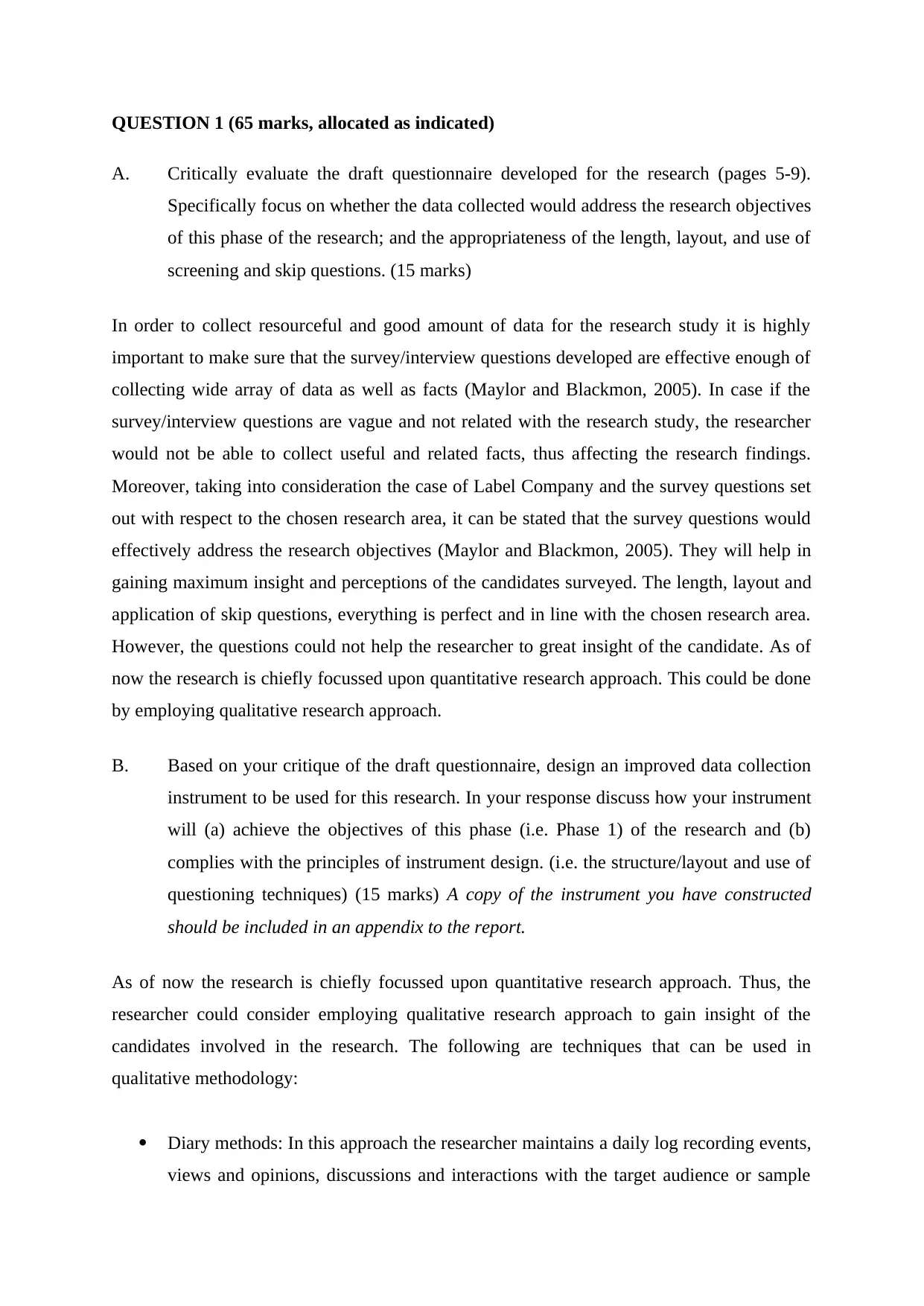
QUESTION 1 (65 marks, allocated as indicated)
A. Critically evaluate the draft questionnaire developed for the research (pages 5-9).
Specifically focus on whether the data collected would address the research objectives
of this phase of the research; and the appropriateness of the length, layout, and use of
screening and skip questions. (15 marks)
In order to collect resourceful and good amount of data for the research study it is highly
important to make sure that the survey/interview questions developed are effective enough of
collecting wide array of data as well as facts (Maylor and Blackmon, 2005). In case if the
survey/interview questions are vague and not related with the research study, the researcher
would not be able to collect useful and related facts, thus affecting the research findings.
Moreover, taking into consideration the case of Label Company and the survey questions set
out with respect to the chosen research area, it can be stated that the survey questions would
effectively address the research objectives (Maylor and Blackmon, 2005). They will help in
gaining maximum insight and perceptions of the candidates surveyed. The length, layout and
application of skip questions, everything is perfect and in line with the chosen research area.
However, the questions could not help the researcher to great insight of the candidate. As of
now the research is chiefly focussed upon quantitative research approach. This could be done
by employing qualitative research approach.
B. Based on your critique of the draft questionnaire, design an improved data collection
instrument to be used for this research. In your response discuss how your instrument
will (a) achieve the objectives of this phase (i.e. Phase 1) of the research and (b)
complies with the principles of instrument design. (i.e. the structure/layout and use of
questioning techniques) (15 marks) A copy of the instrument you have constructed
should be included in an appendix to the report.
As of now the research is chiefly focussed upon quantitative research approach. Thus, the
researcher could consider employing qualitative research approach to gain insight of the
candidates involved in the research. The following are techniques that can be used in
qualitative methodology:
Diary methods: In this approach the researcher maintains a daily log recording events,
views and opinions, discussions and interactions with the target audience or sample
A. Critically evaluate the draft questionnaire developed for the research (pages 5-9).
Specifically focus on whether the data collected would address the research objectives
of this phase of the research; and the appropriateness of the length, layout, and use of
screening and skip questions. (15 marks)
In order to collect resourceful and good amount of data for the research study it is highly
important to make sure that the survey/interview questions developed are effective enough of
collecting wide array of data as well as facts (Maylor and Blackmon, 2005). In case if the
survey/interview questions are vague and not related with the research study, the researcher
would not be able to collect useful and related facts, thus affecting the research findings.
Moreover, taking into consideration the case of Label Company and the survey questions set
out with respect to the chosen research area, it can be stated that the survey questions would
effectively address the research objectives (Maylor and Blackmon, 2005). They will help in
gaining maximum insight and perceptions of the candidates surveyed. The length, layout and
application of skip questions, everything is perfect and in line with the chosen research area.
However, the questions could not help the researcher to great insight of the candidate. As of
now the research is chiefly focussed upon quantitative research approach. This could be done
by employing qualitative research approach.
B. Based on your critique of the draft questionnaire, design an improved data collection
instrument to be used for this research. In your response discuss how your instrument
will (a) achieve the objectives of this phase (i.e. Phase 1) of the research and (b)
complies with the principles of instrument design. (i.e. the structure/layout and use of
questioning techniques) (15 marks) A copy of the instrument you have constructed
should be included in an appendix to the report.
As of now the research is chiefly focussed upon quantitative research approach. Thus, the
researcher could consider employing qualitative research approach to gain insight of the
candidates involved in the research. The following are techniques that can be used in
qualitative methodology:
Diary methods: In this approach the researcher maintains a daily log recording events,
views and opinions, discussions and interactions with the target audience or sample
Paraphrase This Document
Need a fresh take? Get an instant paraphrase of this document with our AI Paraphraser
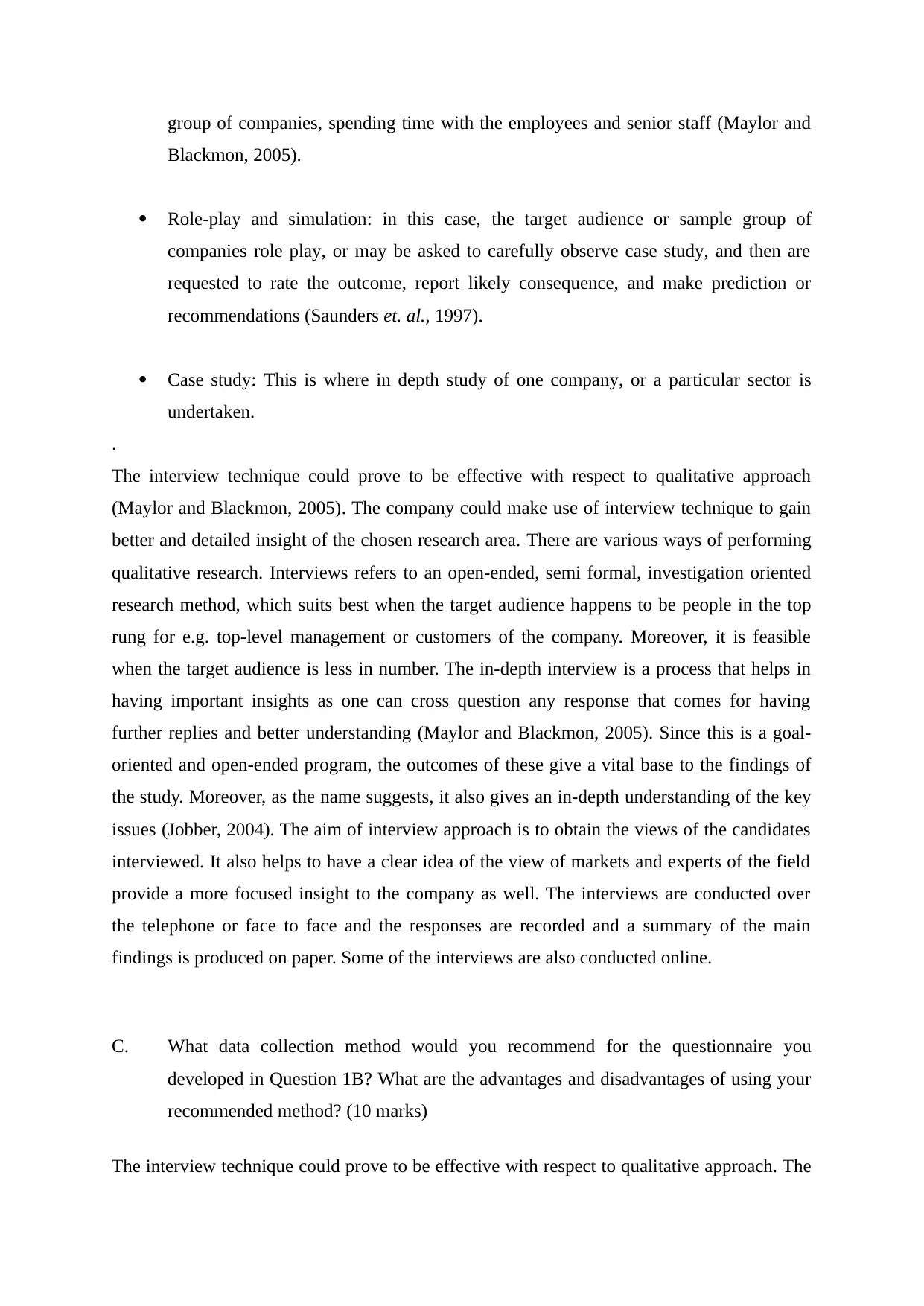
group of companies, spending time with the employees and senior staff (Maylor and
Blackmon, 2005).
Role-play and simulation: in this case, the target audience or sample group of
companies role play, or may be asked to carefully observe case study, and then are
requested to rate the outcome, report likely consequence, and make prediction or
recommendations (Saunders et. al., 1997).
Case study: This is where in depth study of one company, or a particular sector is
undertaken.
.
The interview technique could prove to be effective with respect to qualitative approach
(Maylor and Blackmon, 2005). The company could make use of interview technique to gain
better and detailed insight of the chosen research area. There are various ways of performing
qualitative research. Interviews refers to an open-ended, semi formal, investigation oriented
research method, which suits best when the target audience happens to be people in the top
rung for e.g. top-level management or customers of the company. Moreover, it is feasible
when the target audience is less in number. The in-depth interview is a process that helps in
having important insights as one can cross question any response that comes for having
further replies and better understanding (Maylor and Blackmon, 2005). Since this is a goal-
oriented and open-ended program, the outcomes of these give a vital base to the findings of
the study. Moreover, as the name suggests, it also gives an in-depth understanding of the key
issues (Jobber, 2004). The aim of interview approach is to obtain the views of the candidates
interviewed. It also helps to have a clear idea of the view of markets and experts of the field
provide a more focused insight to the company as well. The interviews are conducted over
the telephone or face to face and the responses are recorded and a summary of the main
findings is produced on paper. Some of the interviews are also conducted online.
C. What data collection method would you recommend for the questionnaire you
developed in Question 1B? What are the advantages and disadvantages of using your
recommended method? (10 marks)
The interview technique could prove to be effective with respect to qualitative approach. The
Blackmon, 2005).
Role-play and simulation: in this case, the target audience or sample group of
companies role play, or may be asked to carefully observe case study, and then are
requested to rate the outcome, report likely consequence, and make prediction or
recommendations (Saunders et. al., 1997).
Case study: This is where in depth study of one company, or a particular sector is
undertaken.
.
The interview technique could prove to be effective with respect to qualitative approach
(Maylor and Blackmon, 2005). The company could make use of interview technique to gain
better and detailed insight of the chosen research area. There are various ways of performing
qualitative research. Interviews refers to an open-ended, semi formal, investigation oriented
research method, which suits best when the target audience happens to be people in the top
rung for e.g. top-level management or customers of the company. Moreover, it is feasible
when the target audience is less in number. The in-depth interview is a process that helps in
having important insights as one can cross question any response that comes for having
further replies and better understanding (Maylor and Blackmon, 2005). Since this is a goal-
oriented and open-ended program, the outcomes of these give a vital base to the findings of
the study. Moreover, as the name suggests, it also gives an in-depth understanding of the key
issues (Jobber, 2004). The aim of interview approach is to obtain the views of the candidates
interviewed. It also helps to have a clear idea of the view of markets and experts of the field
provide a more focused insight to the company as well. The interviews are conducted over
the telephone or face to face and the responses are recorded and a summary of the main
findings is produced on paper. Some of the interviews are also conducted online.
C. What data collection method would you recommend for the questionnaire you
developed in Question 1B? What are the advantages and disadvantages of using your
recommended method? (10 marks)
The interview technique could prove to be effective with respect to qualitative approach. The
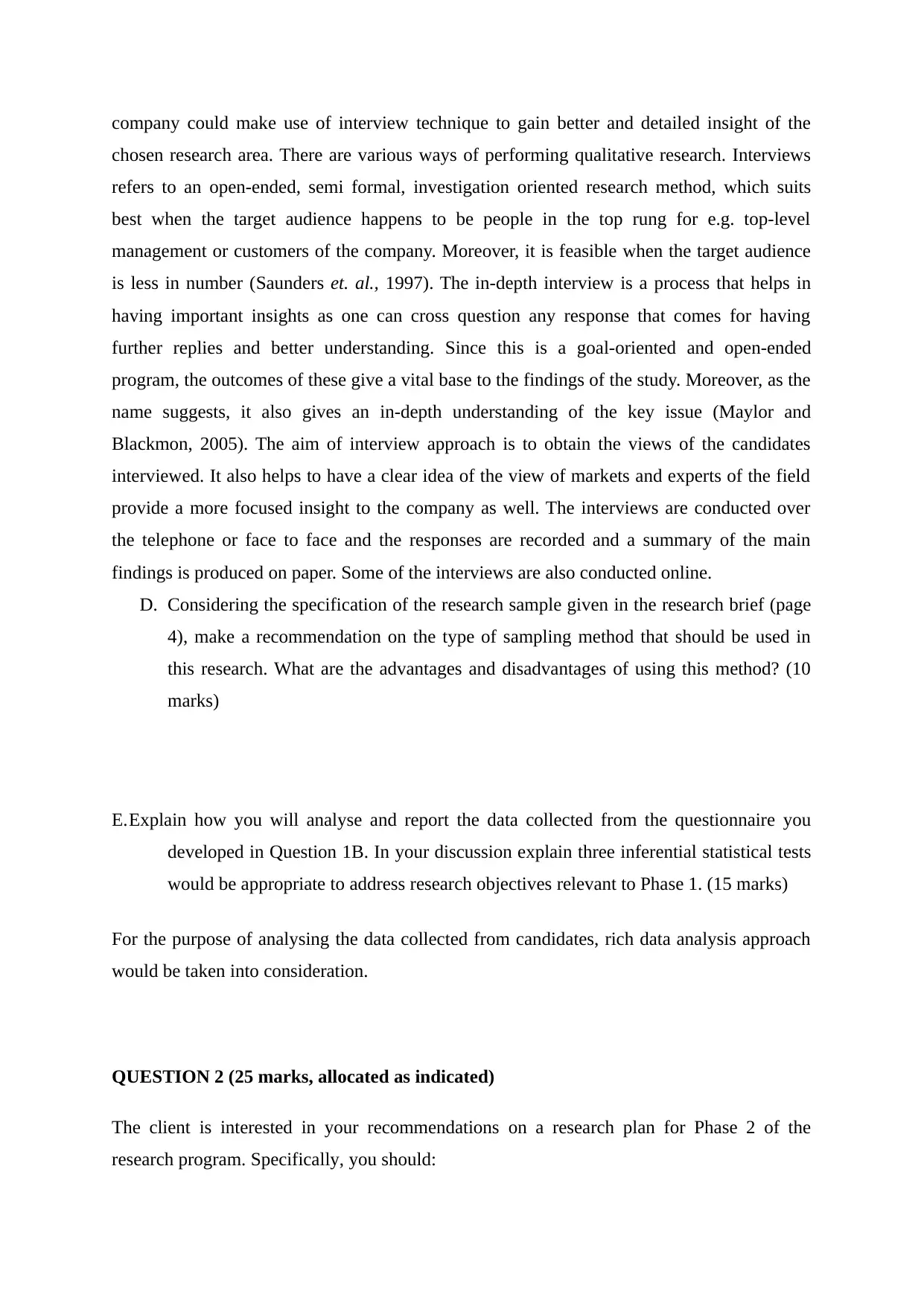
company could make use of interview technique to gain better and detailed insight of the
chosen research area. There are various ways of performing qualitative research. Interviews
refers to an open-ended, semi formal, investigation oriented research method, which suits
best when the target audience happens to be people in the top rung for e.g. top-level
management or customers of the company. Moreover, it is feasible when the target audience
is less in number (Saunders et. al., 1997). The in-depth interview is a process that helps in
having important insights as one can cross question any response that comes for having
further replies and better understanding. Since this is a goal-oriented and open-ended
program, the outcomes of these give a vital base to the findings of the study. Moreover, as the
name suggests, it also gives an in-depth understanding of the key issue (Maylor and
Blackmon, 2005). The aim of interview approach is to obtain the views of the candidates
interviewed. It also helps to have a clear idea of the view of markets and experts of the field
provide a more focused insight to the company as well. The interviews are conducted over
the telephone or face to face and the responses are recorded and a summary of the main
findings is produced on paper. Some of the interviews are also conducted online.
D. Considering the specification of the research sample given in the research brief (page
4), make a recommendation on the type of sampling method that should be used in
this research. What are the advantages and disadvantages of using this method? (10
marks)
E.Explain how you will analyse and report the data collected from the questionnaire you
developed in Question 1B. In your discussion explain three inferential statistical tests
would be appropriate to address research objectives relevant to Phase 1. (15 marks)
For the purpose of analysing the data collected from candidates, rich data analysis approach
would be taken into consideration.
QUESTION 2 (25 marks, allocated as indicated)
The client is interested in your recommendations on a research plan for Phase 2 of the
research program. Specifically, you should:
chosen research area. There are various ways of performing qualitative research. Interviews
refers to an open-ended, semi formal, investigation oriented research method, which suits
best when the target audience happens to be people in the top rung for e.g. top-level
management or customers of the company. Moreover, it is feasible when the target audience
is less in number (Saunders et. al., 1997). The in-depth interview is a process that helps in
having important insights as one can cross question any response that comes for having
further replies and better understanding. Since this is a goal-oriented and open-ended
program, the outcomes of these give a vital base to the findings of the study. Moreover, as the
name suggests, it also gives an in-depth understanding of the key issue (Maylor and
Blackmon, 2005). The aim of interview approach is to obtain the views of the candidates
interviewed. It also helps to have a clear idea of the view of markets and experts of the field
provide a more focused insight to the company as well. The interviews are conducted over
the telephone or face to face and the responses are recorded and a summary of the main
findings is produced on paper. Some of the interviews are also conducted online.
D. Considering the specification of the research sample given in the research brief (page
4), make a recommendation on the type of sampling method that should be used in
this research. What are the advantages and disadvantages of using this method? (10
marks)
E.Explain how you will analyse and report the data collected from the questionnaire you
developed in Question 1B. In your discussion explain three inferential statistical tests
would be appropriate to address research objectives relevant to Phase 1. (15 marks)
For the purpose of analysing the data collected from candidates, rich data analysis approach
would be taken into consideration.
QUESTION 2 (25 marks, allocated as indicated)
The client is interested in your recommendations on a research plan for Phase 2 of the
research program. Specifically, you should:
⊘ This is a preview!⊘
Do you want full access?
Subscribe today to unlock all pages.

Trusted by 1+ million students worldwide
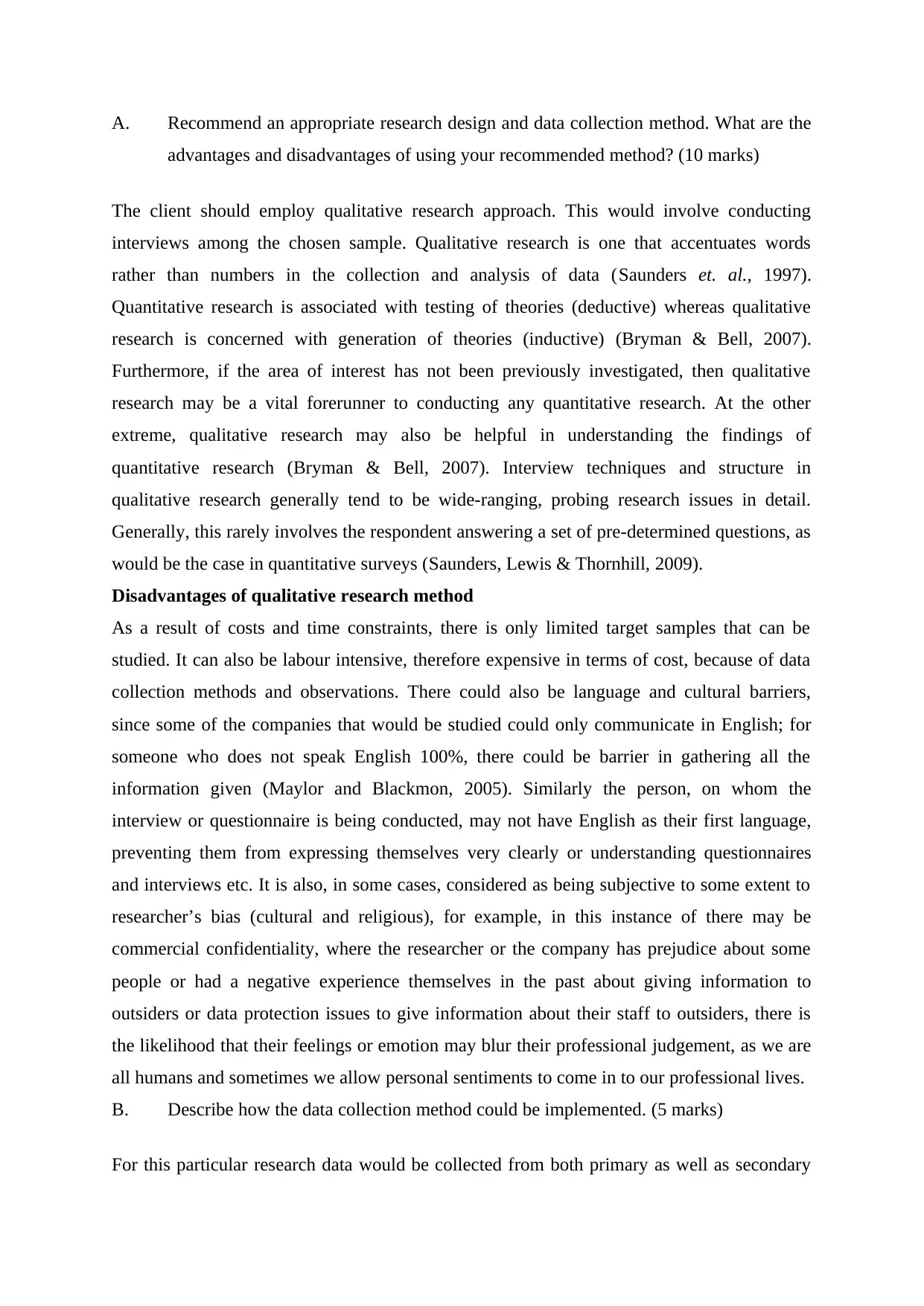
A. Recommend an appropriate research design and data collection method. What are the
advantages and disadvantages of using your recommended method? (10 marks)
The client should employ qualitative research approach. This would involve conducting
interviews among the chosen sample. Qualitative research is one that accentuates words
rather than numbers in the collection and analysis of data (Saunders et. al., 1997).
Quantitative research is associated with testing of theories (deductive) whereas qualitative
research is concerned with generation of theories (inductive) (Bryman & Bell, 2007).
Furthermore, if the area of interest has not been previously investigated, then qualitative
research may be a vital forerunner to conducting any quantitative research. At the other
extreme, qualitative research may also be helpful in understanding the findings of
quantitative research (Bryman & Bell, 2007). Interview techniques and structure in
qualitative research generally tend to be wide-ranging, probing research issues in detail.
Generally, this rarely involves the respondent answering a set of pre-determined questions, as
would be the case in quantitative surveys (Saunders, Lewis & Thornhill, 2009).
Disadvantages of qualitative research method
As a result of costs and time constraints, there is only limited target samples that can be
studied. It can also be labour intensive, therefore expensive in terms of cost, because of data
collection methods and observations. There could also be language and cultural barriers,
since some of the companies that would be studied could only communicate in English; for
someone who does not speak English 100%, there could be barrier in gathering all the
information given (Maylor and Blackmon, 2005). Similarly the person, on whom the
interview or questionnaire is being conducted, may not have English as their first language,
preventing them from expressing themselves very clearly or understanding questionnaires
and interviews etc. It is also, in some cases, considered as being subjective to some extent to
researcher’s bias (cultural and religious), for example, in this instance of there may be
commercial confidentiality, where the researcher or the company has prejudice about some
people or had a negative experience themselves in the past about giving information to
outsiders or data protection issues to give information about their staff to outsiders, there is
the likelihood that their feelings or emotion may blur their professional judgement, as we are
all humans and sometimes we allow personal sentiments to come in to our professional lives.
B. Describe how the data collection method could be implemented. (5 marks)
For this particular research data would be collected from both primary as well as secondary
advantages and disadvantages of using your recommended method? (10 marks)
The client should employ qualitative research approach. This would involve conducting
interviews among the chosen sample. Qualitative research is one that accentuates words
rather than numbers in the collection and analysis of data (Saunders et. al., 1997).
Quantitative research is associated with testing of theories (deductive) whereas qualitative
research is concerned with generation of theories (inductive) (Bryman & Bell, 2007).
Furthermore, if the area of interest has not been previously investigated, then qualitative
research may be a vital forerunner to conducting any quantitative research. At the other
extreme, qualitative research may also be helpful in understanding the findings of
quantitative research (Bryman & Bell, 2007). Interview techniques and structure in
qualitative research generally tend to be wide-ranging, probing research issues in detail.
Generally, this rarely involves the respondent answering a set of pre-determined questions, as
would be the case in quantitative surveys (Saunders, Lewis & Thornhill, 2009).
Disadvantages of qualitative research method
As a result of costs and time constraints, there is only limited target samples that can be
studied. It can also be labour intensive, therefore expensive in terms of cost, because of data
collection methods and observations. There could also be language and cultural barriers,
since some of the companies that would be studied could only communicate in English; for
someone who does not speak English 100%, there could be barrier in gathering all the
information given (Maylor and Blackmon, 2005). Similarly the person, on whom the
interview or questionnaire is being conducted, may not have English as their first language,
preventing them from expressing themselves very clearly or understanding questionnaires
and interviews etc. It is also, in some cases, considered as being subjective to some extent to
researcher’s bias (cultural and religious), for example, in this instance of there may be
commercial confidentiality, where the researcher or the company has prejudice about some
people or had a negative experience themselves in the past about giving information to
outsiders or data protection issues to give information about their staff to outsiders, there is
the likelihood that their feelings or emotion may blur their professional judgement, as we are
all humans and sometimes we allow personal sentiments to come in to our professional lives.
B. Describe how the data collection method could be implemented. (5 marks)
For this particular research data would be collected from both primary as well as secondary
Paraphrase This Document
Need a fresh take? Get an instant paraphrase of this document with our AI Paraphraser
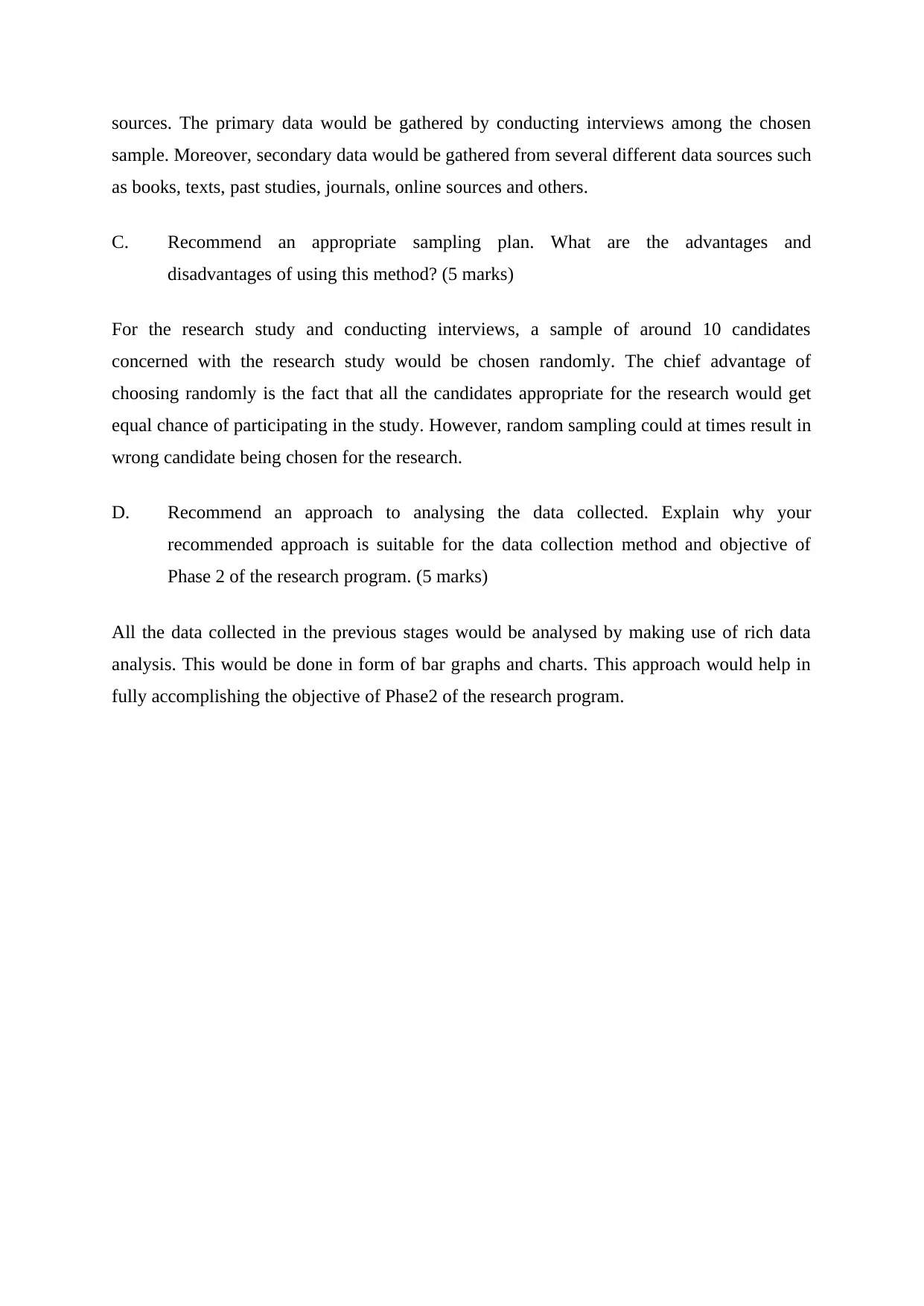
sources. The primary data would be gathered by conducting interviews among the chosen
sample. Moreover, secondary data would be gathered from several different data sources such
as books, texts, past studies, journals, online sources and others.
C. Recommend an appropriate sampling plan. What are the advantages and
disadvantages of using this method? (5 marks)
For the research study and conducting interviews, a sample of around 10 candidates
concerned with the research study would be chosen randomly. The chief advantage of
choosing randomly is the fact that all the candidates appropriate for the research would get
equal chance of participating in the study. However, random sampling could at times result in
wrong candidate being chosen for the research.
D. Recommend an approach to analysing the data collected. Explain why your
recommended approach is suitable for the data collection method and objective of
Phase 2 of the research program. (5 marks)
All the data collected in the previous stages would be analysed by making use of rich data
analysis. This would be done in form of bar graphs and charts. This approach would help in
fully accomplishing the objective of Phase2 of the research program.
sample. Moreover, secondary data would be gathered from several different data sources such
as books, texts, past studies, journals, online sources and others.
C. Recommend an appropriate sampling plan. What are the advantages and
disadvantages of using this method? (5 marks)
For the research study and conducting interviews, a sample of around 10 candidates
concerned with the research study would be chosen randomly. The chief advantage of
choosing randomly is the fact that all the candidates appropriate for the research would get
equal chance of participating in the study. However, random sampling could at times result in
wrong candidate being chosen for the research.
D. Recommend an approach to analysing the data collected. Explain why your
recommended approach is suitable for the data collection method and objective of
Phase 2 of the research program. (5 marks)
All the data collected in the previous stages would be analysed by making use of rich data
analysis. This would be done in form of bar graphs and charts. This approach would help in
fully accomplishing the objective of Phase2 of the research program.
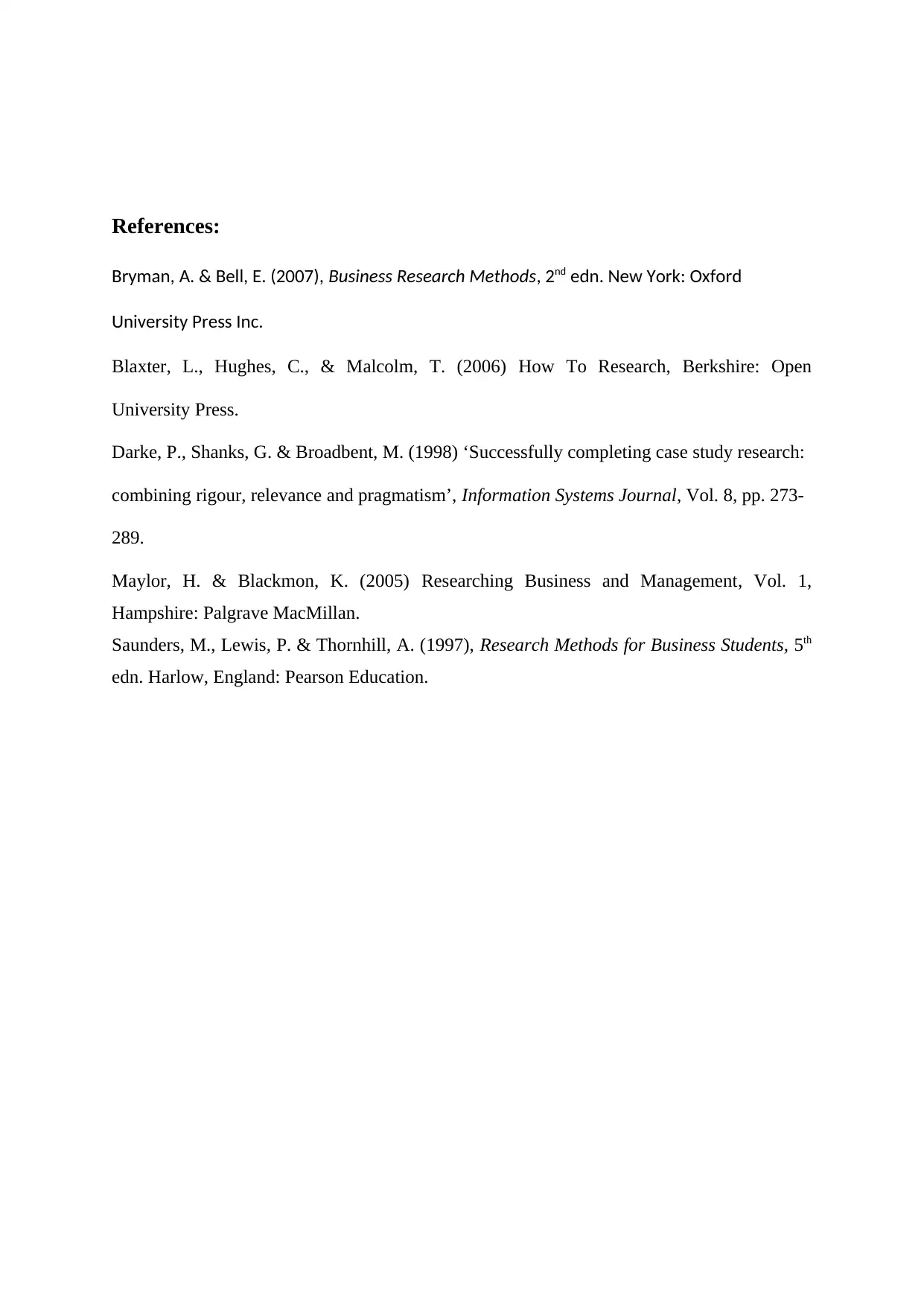
References:
Bryman, A. & Bell, E. (2007), Business Research Methods, 2nd edn. New York: Oxford
University Press Inc.
Blaxter, L., Hughes, C., & Malcolm, T. (2006) How To Research, Berkshire: Open
University Press.
Darke, P., Shanks, G. & Broadbent, M. (1998) ‘Successfully completing case study research:
combining rigour, relevance and pragmatism’, Information Systems Journal, Vol. 8, pp. 273-
289.
Maylor, H. & Blackmon, K. (2005) Researching Business and Management, Vol. 1,
Hampshire: Palgrave MacMillan.
Saunders, M., Lewis, P. & Thornhill, A. (1997), Research Methods for Business Students, 5th
edn. Harlow, England: Pearson Education.
Bryman, A. & Bell, E. (2007), Business Research Methods, 2nd edn. New York: Oxford
University Press Inc.
Blaxter, L., Hughes, C., & Malcolm, T. (2006) How To Research, Berkshire: Open
University Press.
Darke, P., Shanks, G. & Broadbent, M. (1998) ‘Successfully completing case study research:
combining rigour, relevance and pragmatism’, Information Systems Journal, Vol. 8, pp. 273-
289.
Maylor, H. & Blackmon, K. (2005) Researching Business and Management, Vol. 1,
Hampshire: Palgrave MacMillan.
Saunders, M., Lewis, P. & Thornhill, A. (1997), Research Methods for Business Students, 5th
edn. Harlow, England: Pearson Education.
⊘ This is a preview!⊘
Do you want full access?
Subscribe today to unlock all pages.

Trusted by 1+ million students worldwide
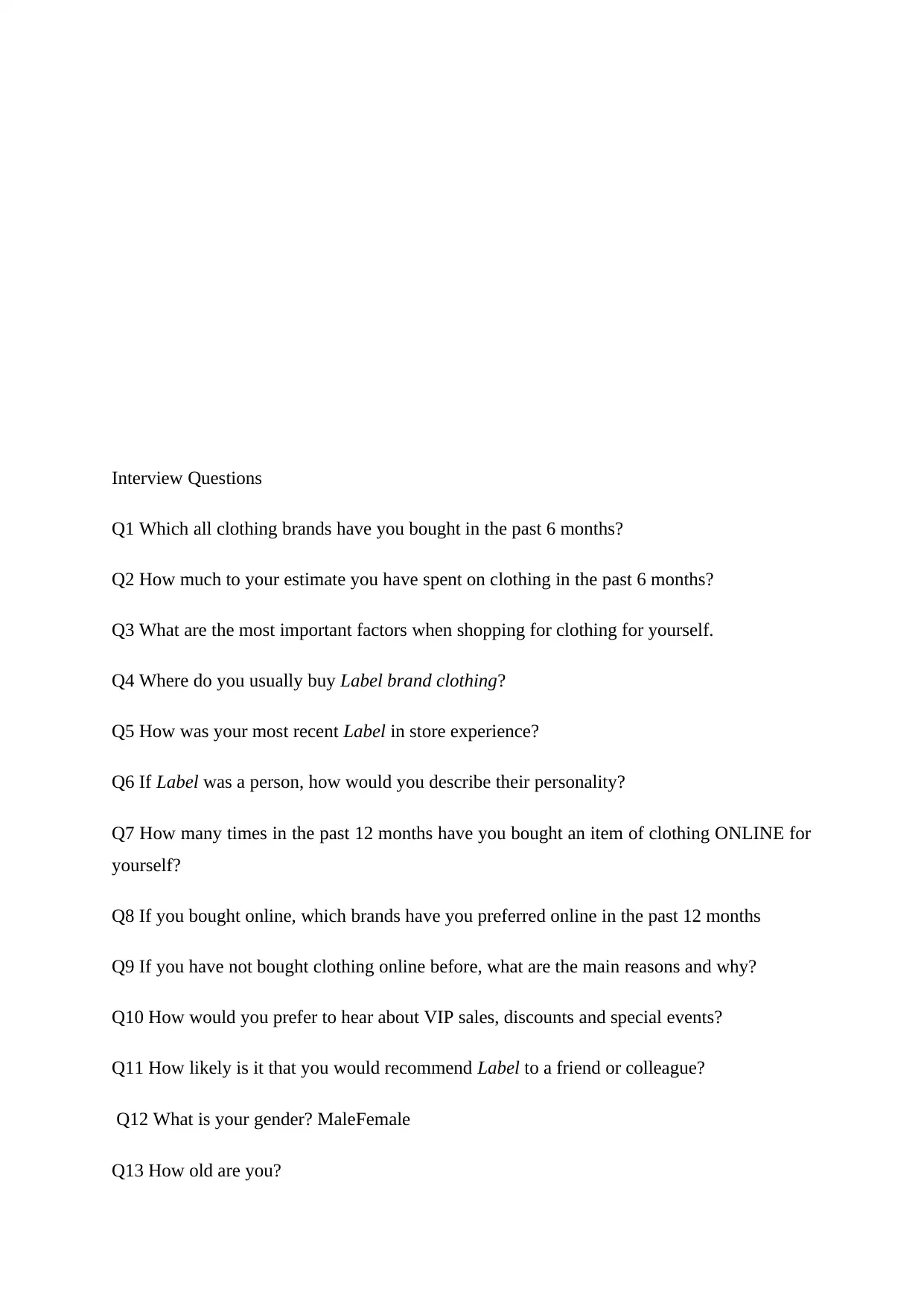
Interview Questions
Q1 Which all clothing brands have you bought in the past 6 months?
Q2 How much to your estimate you have spent on clothing in the past 6 months?
Q3 What are the most important factors when shopping for clothing for yourself.
Q4 Where do you usually buy Label brand clothing?
Q5 How was your most recent Label in store experience?
Q6 If Label was a person, how would you describe their personality?
Q7 How many times in the past 12 months have you bought an item of clothing ONLINE for
yourself?
Q8 If you bought online, which brands have you preferred online in the past 12 months
Q9 If you have not bought clothing online before, what are the main reasons and why?
Q10 How would you prefer to hear about VIP sales, discounts and special events?
Q11 How likely is it that you would recommend Label to a friend or colleague?
Q12 What is your gender? MaleFemale
Q13 How old are you?
Q1 Which all clothing brands have you bought in the past 6 months?
Q2 How much to your estimate you have spent on clothing in the past 6 months?
Q3 What are the most important factors when shopping for clothing for yourself.
Q4 Where do you usually buy Label brand clothing?
Q5 How was your most recent Label in store experience?
Q6 If Label was a person, how would you describe their personality?
Q7 How many times in the past 12 months have you bought an item of clothing ONLINE for
yourself?
Q8 If you bought online, which brands have you preferred online in the past 12 months
Q9 If you have not bought clothing online before, what are the main reasons and why?
Q10 How would you prefer to hear about VIP sales, discounts and special events?
Q11 How likely is it that you would recommend Label to a friend or colleague?
Q12 What is your gender? MaleFemale
Q13 How old are you?
Paraphrase This Document
Need a fresh take? Get an instant paraphrase of this document with our AI Paraphraser
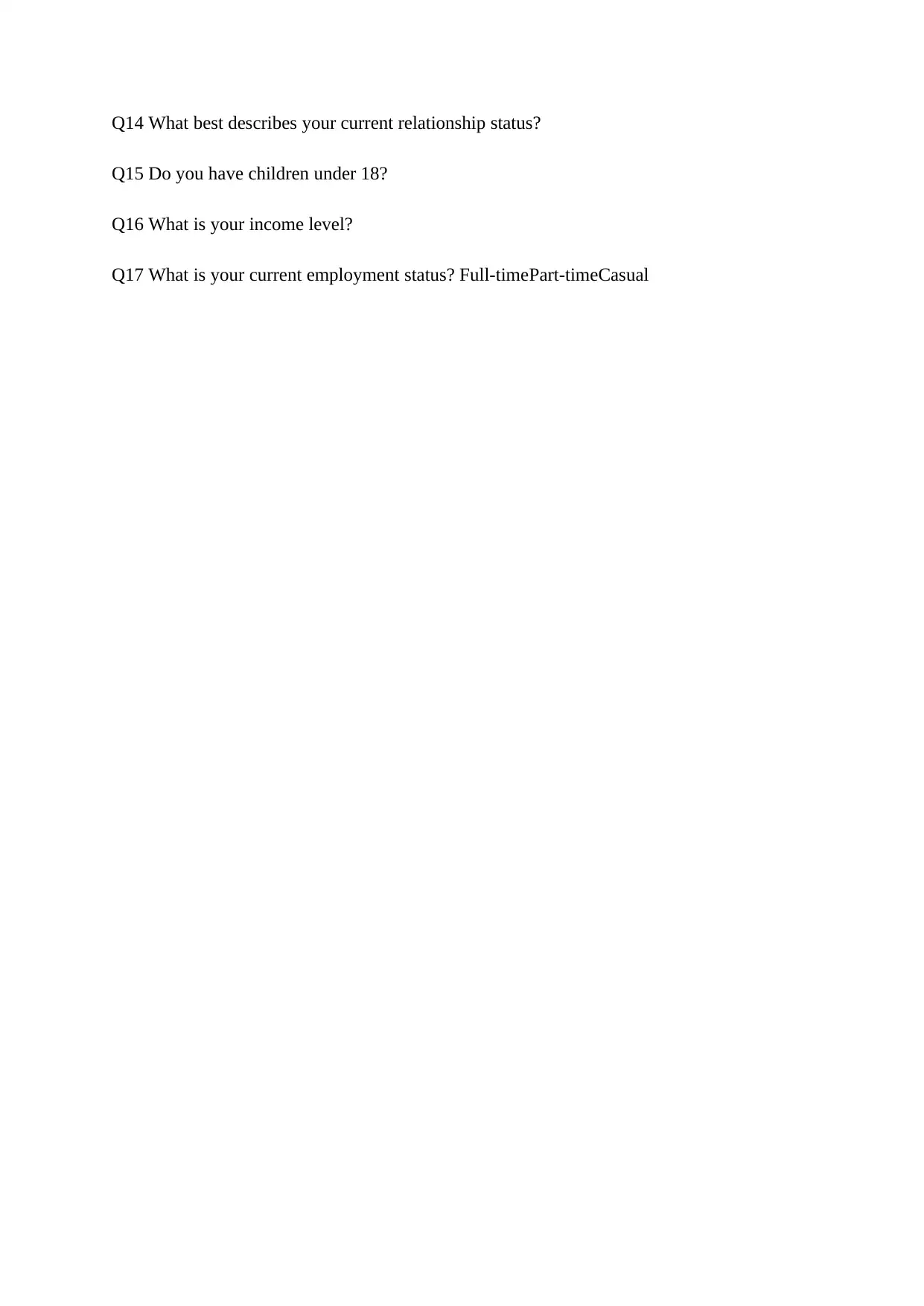
Q14 What best describes your current relationship status?
Q15 Do you have children under 18?
Q16 What is your income level?
Q17 What is your current employment status? Full-timePart-timeCasual
Q15 Do you have children under 18?
Q16 What is your income level?
Q17 What is your current employment status? Full-timePart-timeCasual
1 out of 8
Related Documents
Your All-in-One AI-Powered Toolkit for Academic Success.
+13062052269
info@desklib.com
Available 24*7 on WhatsApp / Email
![[object Object]](/_next/static/media/star-bottom.7253800d.svg)
Unlock your academic potential
Copyright © 2020–2025 A2Z Services. All Rights Reserved. Developed and managed by ZUCOL.




